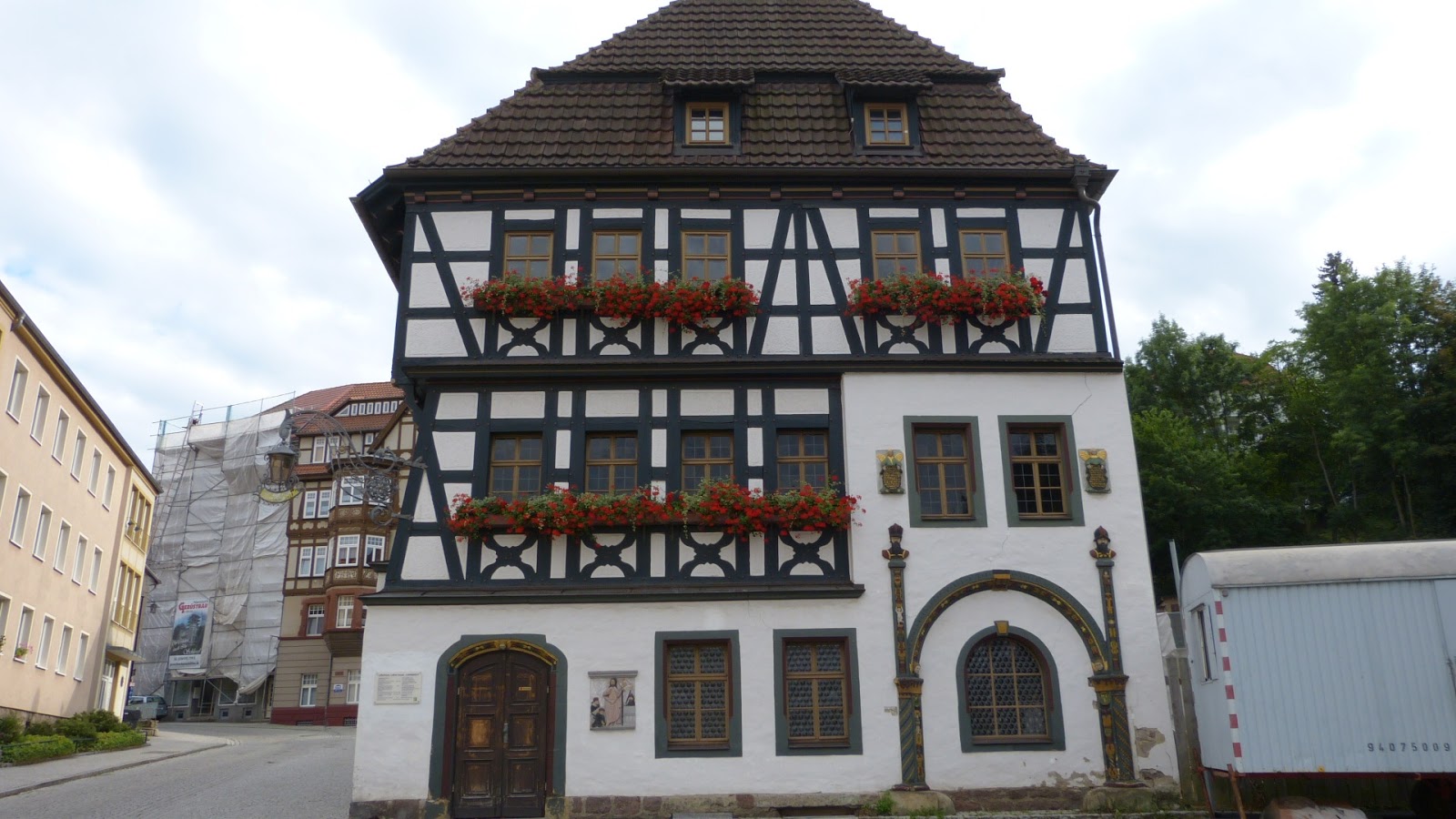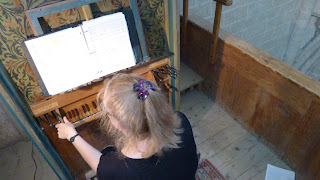Egyptian organ:
The big modern concert organ
The beautiful 17th century organ
Later that afternoon we got to the instrument museum in Stuttgart, where we planned to look at the Stein fortepianos in particular, and many other instruments also. But, the person we had intended to meet couldn't make it at the last minute, so we toured the instruments without playing them. Afterwards we checked into our Stuttgart hotel.
'The next morning - disaster! Alas, I had had my notebook with all my music - fortepiano, organ concerts - in my hand when we toured. It was nowhere to be found in the Mercedes or in our room. Thinking carefully, I realized I had set it down at some point in the tour around the museum, and....had very likely not picked it up again. (Here's where the blog should be "Life of an ADD organist". The museum was entirely closed on Monday, and no one picked up our phone calls to the music department. Fortunately, our schedule was entirely flexible, so we decided to stay until Tuesday morning, visit the museum again, and hopefully retrieve the notebook. I cannot lie: I was a nervous wreck thinking about what if it could not be found...which pile had my Faenza codex at Immanuel Church and who could possibly find it, pull out the correct untitled dance (one of many), scan it...that's just one piece...(I could almost more easily resurrect it from memory - maybe - with the help of the recent videos...there were at least 30 pieces in there that I absolutely needed in the 3 entirely different programs over the next 3 weeks.
Monday was spent working, both of us: I was formatting the ARTEK season brochure, Dongsok editing our Rosenmuller CD. And some shopping. A day without any keyboards whatsoever...how strange...first time this trip.
On Tuesday we went to the museum. For about a half hour it seemed that the notebook no longer existed, no one had found it, cleaning people had come in on Monday and who knew...cold sweat here. Then suddenly the nice receptionist realized she had an extra black notebook in her desk - and it was mine! Yes!!! All was OK again. The bonus was that this time we were able to play the instruments. One Stein we liked very much; the other seemed to have exceptionally hard, bright-sounding hammer covers which was interesting but not very fun to play. We also played a simply wonderful early French (17th century) harpsichord, and an early Italian harpsichord (below). That was a highlight for me.
Then we moved on towards a hotel in the town of Weimar. Dongsok had decided he would like to hang out in "the land of Bach" and see his birthplace, churches he had played in, and towns & cities where he had worked for the next few days.
On the way, we stopped at the Würzburg Residenz, home of the Bishop princes of Würzburg, built in the 18th century. No keyboards, but beautiful ceiling paintings and frescos by Tiepolo. Yay for Italians!
In Weimar, we did some touring around this lovely 18th century town, with its huge number of palace-like buildings. And ate Hungarian food. Below- plaque commemorating where Bach USED to live in Weimar.
The next day, we visited the Bachhaus, in Eisenach (place of Bach's birth), which Dongsok had visited in the past, over ten years ago. Like many attractions in the former East Germany section, it had changed much in the time since he had been there last. This is a house - unfortunately not exactly the house he had been born in, but one very near to it - with exhibits on his life and a number of keyboard instruments. One we had hoped to see, a small early German harpsichord, was no longer being exhibited, however. The other instruments included a modern harpsichord and spinet, an antique clavichord, and two antique organs from the region. A young teen did the demonstration; alas, had she been Bach's child, I think she would have been sent to bed without any supper for her performance! She played, very nervously, a few pieces from Anna Magdalena & Willhelm Friedemann books, and became totally lost in the last piece on the harpsichord and had to stop without finishing it! (I felt a bit like whispering "G sharp in the bass!" but I restrained myself...Afterwards she told us she was a music education student. (Fortunately, only 5 people in the audience!). Sad to say, although she was allowed to demonstrate the instruments ((despite her lack of ability) we were not allowed to touch the antique organs or clavichord. Sigh.
We also looked into the church in Eisenach where Bach was baptised, and the Latin school that Martin Luther attended 200 years before Bach's time. (Turns out Bach Land is also Luther Land. Not much surprise there!) Here's the Luther House in Eisenach, below.
We spent some more time on our music editing/graphic design work and then moved on to Dresden on Thursday. There, we visited Schloss Pillnitz where resides the original 5-octave Gräbner harpsichord. This is the instrument I have ordered a copy of from the esteemed American builder and harpsichord restorer, John Phillips. No playing though - even though we had tried sending emails much earlier, we had been warned that it is difficult to make a connection to a curator to actually try out an instrument in this area of Germany.
Although the Gräbner is a rather plainly decorated instrument - thought to be originally intended for use at the Dresden Opera House - the castle was filled with examples of fabulous chinoiserie, which is the decoration I am ordering for my own Gräbner.

And here's another instrument at Schloss Pillnitz - a harpsichord-hidden-in-a-piece-of-furniture.
Very efficient for NYC apartments! And cute.
We also went into the center of Dresden, where we marveled at the amount of reconstruction since World War 2, and visited the rebuilt Dresden Frauenkirche, with its large and beautiful baroque-replica organ case (originally a Silbermann, totally destroyed in WW2 also, now a modern organ instrument with 8,192 levels of memory. Gee but I think I might actually need 8,193 if I ever play there...what to do...). We also saw the Hofkirche in Dresden which does still retain its original, restored, 18th century Silbermann organ. (With exactly zero levels of memory :)
The no-memory Silbermann in the Hofkirche
The next day, we went on to Berlin, where we visited the Charlottenburg Palace in Berlin, with a small Silbermann organ in the royal chapel.
Exterior of the palace, and Dongsok, feeling the heat.
Charlottenburg was a fascinating palace complex, particularly because so much of it was built and decorated in the Chinese style which was a serious fad in the 18th century, apparently. Many more examples of Chinoiserie decoration to take note of for our Gräbner decoration. (Black shows off the gold decoration the best but...red chinoiserie is so fabulous...we have until October to decide...).
In that palace, there are two 18th century harpsichords by Miettke with chinoiserie decoration - one a white background (very, very beautiful, but in New York...I feel it would be like wearing white pants on the subway) and one with a black background.
Just enough time that day to also head towards Potsdam and Frederick the Great's palace at Sans Souci. There are so many buildings and palaces connected to Frederick the Great and Sans Souci that it's actually a bit difficult to find the right one.
We knew there was a Silbermann piano there; we found a room with a closed keyboard instrument that the docent in the room assured us was a Silbermann, with hammers, not a clavecin, from1747. And Bach had played it. Hm. Looked suspiciously like an English style harpsichord, but we couldn't get too close, and the keyboard was covered. No other keyboards on exhibit. (There should have been at least two Silbermanns, actually.) Well, some internet search later confirmed that what we saw was indeed an English harpsichord, a Shudi, one of two that Frederick the Great owned, ordered by him in 1764. Don't think JS Bach ever played that; but likely CPE did.
On Saturday, we said goodbye to our quite wonderful, dust-covered Mercedes (now plaintively complaining every startup to please give me my 25,000 km checkup) at the Berlin airport and flew to Krakow in Poland - via a stop in Frankfurt, A bit roundabout way to get there, but an easy trip.



















































